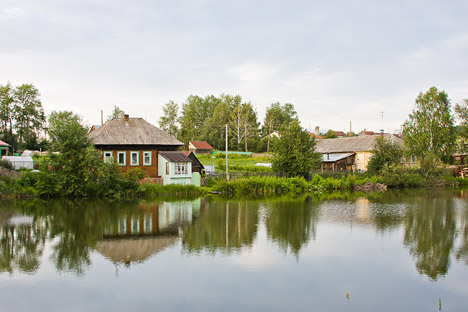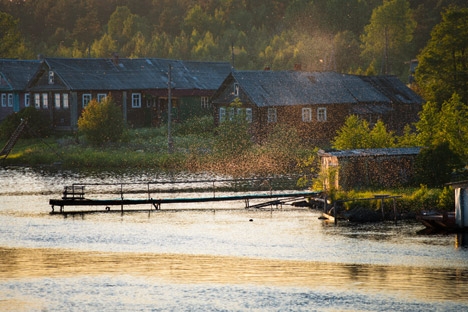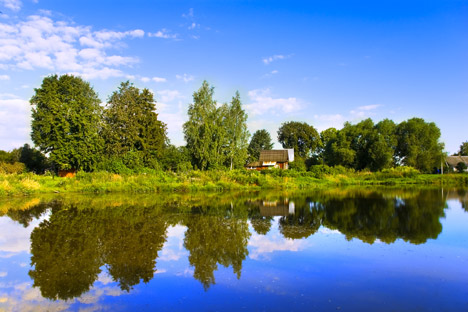Agritourism develops in Russia’s unique rural spaces

Agritourism pioneers in Russia. Pictured: A village in the Perm Territory, Russia. Source: Lori / Legion Media
{***Agritourism with minimal comfort***}
Agritourism with minimal comfort
Vera Ivanova does not look like a businesswoman: she is a short and agile lady, nearly 50. Ivanova settled in the Kaluga Region village of Meshkov, 12 years ago. Actually, Meshkov is not really a village; it is more of a hamlet on the edge of a ravine in the shade of centuries-old lime trees, where three log huts provide board and lodging for hosts and guests (12 people in all).
Prices
The process of transforming a log cabin into a respectable guesthouse can set owners back anywhere from 150,000 to 2 million rubles ($4,800-64,700). Everything depends on the initial condition of the house, the required level of comfort, and the owner’s skill and craftsmanship. These expenses include repair work, communications, facilities, household goods and appliances, and, sometimes, small livestock.
“My second husband had a cherished dream: to live in a village and plant a fruit garden. At the time, I ran a tour firm in Kaluga and a bar called ‘The Old Horseshoe.’ But I was so in love that, if he’d said: ‘I want to live in Kamchatka,’ I’d have followed him to Kamchatka,’ Vera Ivanovna said, smiling. “And since I didn’t know how to milk a cow or grow food but had to put bread on the table, I decided to go into tourism.”
Vera revealed that each house cost approximately 250,000 rubles ($8,100), which, without her business know-how, would have been more. “We had no cash to spare; so we drove around the region looking for old houses for sale, bought them, dismantled them, and placed them here on a new foundation,” she said, divulging her entrepreneurial secrets.
However, the interior decor belies the moderate costs. “Picturesque” is a word that springs to mind. There is even a cradle, about 100 years old, a wooden spinning wheel, handmade dolls, and colorful patchwork bedspreads.
“There is no need to make the house conform to urban standards. I tried that and had my fingers burnt. It’s unnecessary. A person only needs minimal comfort. All they want is to take a break from civilization,” explained the hostess.
Very soon, tourists were knocking on the door. Guests were flocking to the estate under the lime trees before Vera and her husband had time to finish the roofs.
“My native restaurant helped out. It was once the venue for all student and faculty events in Kaluga. And when I said that I had a house in the village, they all came to visit. I still hadn’t finished the repairs, but I was able to receive guests. And everything I earned was put into the business.”
The internet helps to increase the flow of lodgers: social networks, agritourism websites, and forums for hunters and fishermen. “The most effective way to attract clients is by word of mouth,” said Taras Astakhov, chairman of the Association for the Development of Agritourism.
{***Berry-picking in Ryazan***}
Berry-picking in Ryazan

A Russian village. Source: Lori / Legion Media
Every hotel owner attracts guests in their own unique way. Oxana, from the village of Papushevo in Ryazan Oblast, does so by providing a wide range of entertainment. She can talk about the history of the region for hours on end: about the nearby “sorcerers’ village” and about the local craftsman who made a telescope out of a washing machine.
Impetuous, temperamental, and talkative, she is quite new to the guesthouse business. Nonetheless, she has already developed a series of tours and agreed to cooperate with the leading travel firms in Ryazan, involving the whole village in the process.
Agritourism
Agritourism (also known as rural or green tourism) provides vacations in a bucolic setting and in conditions approximately akin to the everyday lives of local villagers. In Russia, this is only just beginning to develop. According to the Association for the Development of Agritourism, Russia is home to around 4,000 rural tourism sites. Experts note that economy class sites draw the highest demand. The initial investment for such a facility is around 200,000-400,000 rubles ($6,400-13,000). To recoup the costs, the facility needs to be occupied by tourists for 60-80 days per year.
Her neighbors take boarders horse-riding and fishing, teach them how to mold and make things, and feed off nature’s products. The trump card, however, is that the pine house stands on the edge of a forest bordered by the Oka Biosphere Reserve, where young bison and white cranes are within eyesight. This is why, despite opening its doors only one and a half years ago, the lodge is never empty – even on weekdays. Guests are in constant supply from tourist agencies.
Oxana was approached independently by a tour operator who found her contact details online. “I received a call from MK Travel. It turns out they’re interested in this segment of the market. Representatives of the firm even distributed our brochures at the local Expocenter and plan to supply us with groups of tourists,” she said.
“One of the secrets of success is to be within 40 kilometers (25 miles) of decent tourist sights and additional types of recreation, such as rafting, skiing, cycling, horse-riding, snowmobiling, or quad-biking. At the very least, there should be fishing, hunting, hiking, berry-picking, mushrooming, handicraft workshops, cooking, and child care,” said Nadzehda Makatrova, CEO of the consulting company Konkretika.
{***For money and the soul***}
For money and the soul

A Russian village. Source: Lori / Legion Media
Viktor Filippovich Raitsyz, a farmer from the hamlet of Starye Petushki near Vladimir, could be called one of the prosperous sorts. Short, stocky, and with a keen sense for business, Filippych (as he is known) has tried his hand at various things — being a shopkeeper, selling water from his own well, and even growing oyster mushrooms. That was before he took up rural tourism four years ago.
“Guests stay from Friday to Sunday on a regular basis — per month about 8-12, sometimes 20 people. To be honest, it’s a bit quiet during the week. If there were guests all the time, each house would rake in up to 100,000 rubles,” said the rural entrepreneur.
Legal literacy
Rural tourism lacks special laws to regulate activity within the field. More often than not, owners are registered as ordinary persons or individual entrepreneurs. Moreover, regional authorities frequently compensate some of the expenses involved in setting up a guesthouse. In some regions of Russia, subsidies are provided to lay roads and gas pipelines; in others, bee-keeping and cattle-breeding are sponsored. Information about specific programs is available from relevant local authorities (administration, ministries) or from neighbors.
However, none of the village hoteliers can boast a full occupancy rate. Agritourism is highly seasonal.
“In summer, the houses are about 70 percent full; in the fall, 10-20 percent; in spring, 10 percent,” said Yuri Balandin, head of the National Association of Rural Tourism Organizations. “On average, for a house to recoup itself, tourists need to be in place 60-80 days per year; but, even then, rural tourism is no Klondike.”
“Whoever opens a business has to spend up to two years on finding clientele. As for revenue: given an average occupancy rate of 5-6 stopovers a week, for a house with two guest rooms, the monthly income is around 60,000 rubles,” said Astakhov. “The payback period on an original investment of just over 2 million rubles is 8-9 years.”
Nadezhda Makatrova of Konkretika agrees: “It’s not a large or quick money-maker. It’s a long-term project for people who genuinely love guests and the rural way of life.”
First published in Russian in Moskovskiye Novosti.
All rights reserved by Rossiyskaya Gazeta.
Subscribe
to our newsletter!
Get the week's best stories straight to your inbox